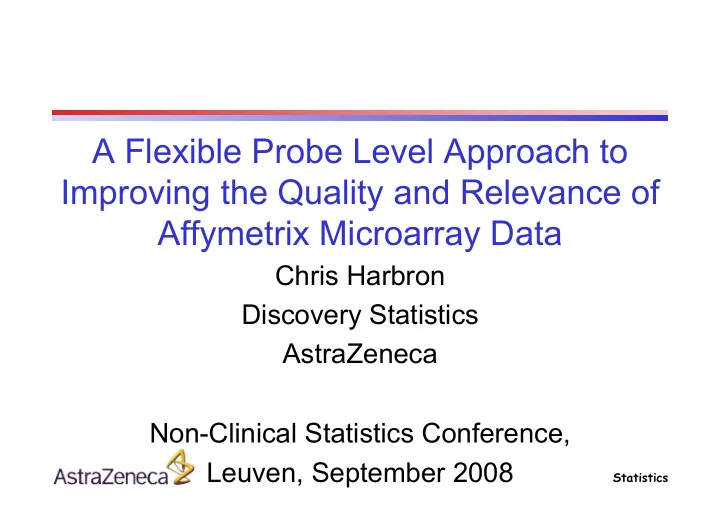

A Flexible Probe Level Approach to Improving the Quality and Relevance of Affymetrix Microarray Data Chris Harbron Discovery Statistics AstraZeneca Non-Clinical Statistics Conference, Leuven, September 2008
Microarrays • � Enable measurements of the levels of gene expression of many thousands of genes simultaneously • � Provides an detailed description of the biology at a molecular level
Uses Of Gene Expression In The Pharmaceutical Industry Drug Drug Marketed Discovery Development Products Identification Understanding Personalised Understanding of drug Modes Of Medicine Drug Safety targets Action Support For Biomarkers For Existing & Early Identifying New Assessment Of Indications Efficacy
Microarrays • � Best thing about • � Worst thing about microarrays: microarrays: • � Analyse 1000s of • � Analyse 1000s of genes genes simultaneously simultaneously • � Won’t miss anything • � Can end up missing the interesting results in a mass of false positives
Reducing False Positives : Filtering • � Often people try and reduce the false positives issue by pre- filtering the genes before analysis – � Present / Absent calls, Variability, Minimum / average expression level • � And by subsequently selecting arbitrary cut-offs post-analysis – � p-value & fold change • � Lots of arbitrary choices • � May miss things – some properties may not directly translate across platforms and species • � Present / Absent calls based on differences between PM & MM – � Assumes no signal in MM which we know to be untrue. – � Also affected by GC content of middle base – � Arbitrary cut-off from significance test
3d fdr Maximise confidence by considering a balance of 3 parameters Quality & Evidence Of Size Of Relevance Separation Separation of Probe Sets (statistical test) (statistical test) Informative 2d fdr Adaptation Genes Ploner et al Talloen et al Ranking of probesets, combining all 3 parameters, with a measure of confidence
3 Correlated Criteria Size Of Separation (statistical test) Evidence Of Difference Test = Separation Statistic Variability (statistical test) Quality & Relevance of Probes
Assessing False Positives Local False Discovery Rate (fdr) Expected proportion of genes with observed statistic Z=z which are false positives Density for f 0 (z) non-DE genes Proportion of truly = x non-DE genes f(z) Observed Density fdr ~ 0.5 fdr ~ 0 Distinct from, but related to, global FDR
2d fdr Ploner et al Bioinformatics 2006 Extends concept of fdr to joint distribution of two statistics -Log 10 p-Value Calculates likelihood of being of each probeset being a false positive based on a combination of significance and difference Log Fold Change – Difference Between Groups
Informative / Non-Informative Calls & The PCPV Statistic I/NI Calls - Talloen et al, Bioinformatics 2007 – � Makes use of the multiple probes in an Affymetrix probeset – � Bayesian estimate of a signal to noise ratio – � If a probeset is informative, then the same pattern should be seen within all the probes within the probeset – � Binary classification PCPV statistic uses similar concept – � Percentage of total variation in probe intensity explained in the first principal component – � Continuous measure of information
Informative / Non-Informative Calls Relationship To PCPV Non-Informative Informative Probe Set Probe Set Low PCPV High PCPV Statistic Statistic
Informative / Non-Informative Calls & The PCPV Statistic • � If a probeset had a low PCPV statistic, i.e. its constituent probes are non-correlated, then either: – � It’s just measuring noise, i.e. there’s no differences between the samples • � Low levels of expression dominated by noise • � No variation in expression between samples – � It’s an unreliable set of probes • � Either way, it’s not very interesting • � Doesn’t necessarily follow that the gene is interesting in the sense of changing with what we are interested in, e.g. treatment
Higher PCPV Statistics Have More Interesting Profiles
Probes With Higher PCPV Statistics Tend To Be More Interesting But not exclusively so
Probes With Higher PCPV Statistics Tend To Be More Interesting But not exclusively so
3d fdr Stratified PCPV Calculate PCPV statistic for each probeset (% of total probe variation in 1 st PC) Probeset Quality Stratify probe sets by PCPV statistics & Relevance Calculate 2d fdr within Significance & each stratum of probesets Difference Combine data across strata and rank probesets by fdr Ranking of probesets, combining all 3 parameters, with a measure of confidence
3d fdr Stratified PCPV fdr ~ 0.75 Entire Set Of Probes Expected distribution of non-DE genes = fdr ~ 0.5 Observed High Quality Probes distribution + fdr ~ 0.95 Low Quality Probes
3d fdr Results 2d fdr 3d fdr Increase in confidence (lower fdr) for high relevance probesets Decrease in confidence (higher fdr) for lower relevance probesets High confidence probesets (low fdr) enriched, but not exclusively, from higher relevance probesets
3d fdr Results
Applicable Over Different DataSets Selected 10 datasets with available covariate information at random from GEO Consistently able to detect genes with more confidence using 3d fdr approach
Summary • � Single ordering of genes combining different properties on a rational basis • � A gene which is outstanding on one parameter, but not others could still be selected for further investigation – � Will get missed with standard “and” selection • � Removes arbitrary filtering decisions • � Tried a robust PCA (as RMA fitting is a robust method – median polish) – � Little change • � Shown for a 2-group t-test – easily extended to ANOVA or regression situation or any other test statistic
Back Up Slides
Relationship Of PCPV to Other Quality Filters Informative Non-Informative ProbeSets ProbeSets
Recommend
More recommend